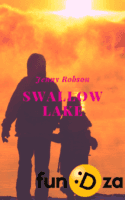“Ao, my Tumi! It is good to understand about Before!”
Grandmother smiles at me, then takes up Lindiwe’s stick. She draws a wide shape in the sand. A magical shape, full and rounded like the belly of an expectant mother. It is a shape that makes me catch my breath, makes my spine tingle even though she has drawn it for me so often.
So beautiful!
The sunset sparkles across the sand, shining like tiny diamonds across my grandmother’s map.
Once, here in Botswana, real diamonds hid in the ground. Until giant earth-movers and bright yellow Caterpillars ripped apart the earth beneath us, grabbing for those ice-blue diamonds. Sending them way across the seas to sparkle on the fingers of Northern women with ice-blue eyes. Leaving behind giant craters and gouged valleys and devastated hill-sides.
“That’s how Afrika looked Before,” says my grandmother. She caresses the soil with worn hands.
She has described this so often, her voice barely trembles. And I have listened so often, but still my heart trembles to hear.
“Finally, Tumi, the earth gave up her fight. With tremors and then with earthquakes, she shuddered and sank. Deeper and deeper.”
This was known as the First Catastrophe. It happened some thirty years ago: up and down the continent, the abused and violated land caved in, with many lives lost beneath the collapsing soil. And when the ground finally stabilised, much of Afrika lay below sea-level.
“And then came the sea,” continues my grandmother. “Flooding Afrika from all sides. Catastrophe beyond bearing!”
This was the Second Catastrophe. It happened back when I was three years old. But no-one wrote it into any school textbooks. Everyone was trying to simply survive.
I know the shape of Afrika as it is today. We have Geography lessons on the RO Educational TV channel, powered by the RO generator. I try to pay attention while Lindiwe and Neo chatter behind me.
Except now it is called the Afrikan Archipelago: a vast collection of large islands. That once-beautiful shape has been sliced apart from the east, carved up from the west. Dismembered like some muti corpse. By the Gauteng Straits, by the Zambezi Channel, the Okavango Gulf.
Further north, the Congo Ocean spreads far and wide to encircle the Buganda Peninsula and the Atolls of Nigeria, before it joins up with the Nile Sea just north of the Kenyan Isles.
My grandmother looks down and sighs. She is old, and she has lived through so much. The orange-brown of her dress is faded so that the traditional patterns barely show. She puts a stone in the southern centre of her map of Before.
She says, “This is where we used to be, here in the landlocked country of Botswana. This is where our village stood. Motswe wa Rona. Far inland. Far from the sea. When I was a little girl, I used to beg my parents: ‘Take me to the sea! I want to play with dolphins and whales and hear the roar of tidal waves. I want to watch big ships sailing.’
I never imagined that one day the sea would come to me!”
***
Tell us: How would you describe the shape of our continent? Which side are you on in this debate: ‘Mining is bad because it destroys the land’ or ‘Mining is good because it is a great source of wealth and employment’?


